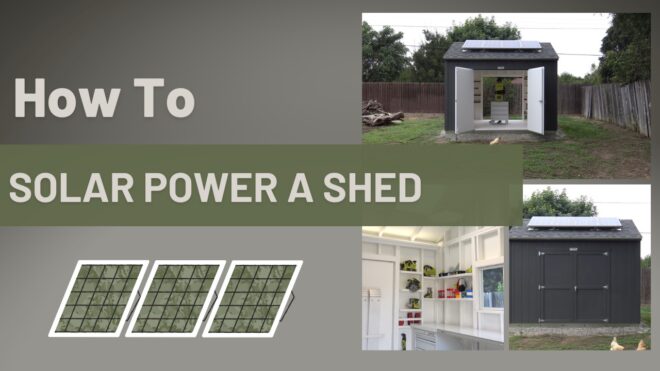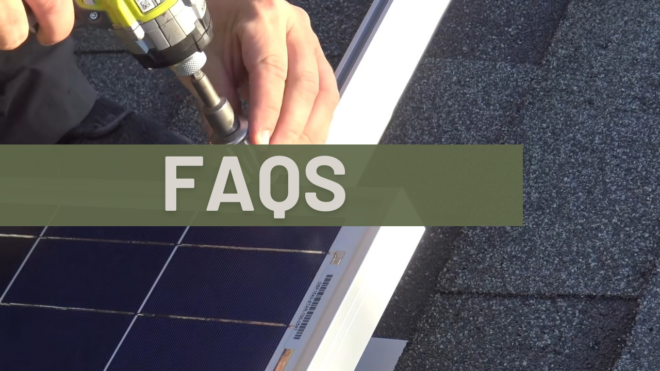Sheds can be an eyesore and a nuisance. They take up valuable space and often become a dumping ground for all sorts of junk. But if you have the space, a shed can make a great home for all sorts of outdoor gear.
And if you want to solar power your shed, that’s even better! Not only will it save you on energy bills, but it’s also an environmentally friendly option. In this blog post, we will walk you through the process of powering your shed using panels and batteries.
What is Solar Power?
Solar power is energy that comes from the sun. Panels use sunlight to turn a solar cell into electricity. There are many different kinds of panels, each with its own advantages and disadvantages. The most common type is the thin-film solar panel. Thin-film panels are made from a thin layer of film that is stretched over a large area.
This type of panel has several advantages over other types of panels: it’s lightweight, flexible, and can be easily mounted on roofs or windows. Thin-film panels have also received some criticism for their low conversion efficiency, which means they produce less electricity than other types.
How does it work?
Solar power works by using the sun’s energy to turn a renewable resource into electricity. Panels are covered in a material that absorbs sunlight and turns it into heat.
This heat is then used to create mechanical energy that can run an electrical generator. The generator produces clean, renewable electricity that you can use to power your home or light up your shed!
What are the benefits?
The benefits of solar power are numerous and varied. Panels provide a clean and sustainable energy source, eliminate the need for fossil fuels, and can be installed on any kind of property. Here are six major benefits:
1. Clean Energy
Solar panels produce electricity using sunlight, which is a clean source of energy. Solar power doesn’t produce emissions like gas or coal-fired plants do, meaning it has a positive impact on the environment.
2. Sustainable Energy
They are an environmentally friendly way to generate energy. They don’t require fuel or maintenance, so they can last indefinitely. This makes solar power an ideal option for long-term sustainability.
3. Reduced CO2 Emissions
Panel installations generate less carbon dioxide than traditional forms of energy generation. This means that solar power reduces greenhouse gas emissions in the atmosphere, helping to combat climate change.
4. Affordable Energy
They are one of the most cost-effective forms of renewable energy available today. Installation costs are relatively low, and monthly electricity bills tend to be lower than average rates for traditional sources of energy such as gas and oil.
5. Ease of Use
Many people are hesitant to switch to renewable energy because they don’t understand how it works or thinks it’s too difficult to use. However, solar power is easy to understand and use – anyone can install a system without any prior experience or technical know-how.
6. Consistent Power
Unlike traditional forms of energy generation, solar panels produce power throughout the day and throughout the year. This means you can count on consistent and reliable energy from your panels, no matter the weather conditions.
Solar panels are a versatile and affordable way to generate clean and sustainable energy. They eliminate the need for fossil fuels, reduce emissions, and are easy to use – making them an ideal choice for anyone looking to reduce their carbon footprint.
How to Power a Shed
There are a few ways to solar power a shed, each with its own advantages and disadvantages. One option is to use a solar panel system. This type of system consists of a mounting frame, panels, and electronics. The panels are installed on the roof or walls of the shed, and the electricity is generated as sunlight hits them. A second option is to use a photovoltaic (PV) battery system.
This system uses panels but also has a battery to store energy collected during daylight hours. When it’s time to use the stored energy, the battery charges up using electricity from the grid or from renewable sources like wind or solar power. The final option is to use both methods together. A PV battery system can store energy from the sun during the daytime, then use that stored energy at night when there’s less sunlight available.
Watch this video for additional tips:
Conclusion
If you’re looking to outsource your shed construction project, solar power is a great option. Not only will this save you time and money, but it will also help reduce the environmental impact of your shed-building project. Check out our guide on how to solar power a shed for more information on how to get started.
FAQs
1. How much does it cost to Solar Power a Shed?
The cost of solar powering a shed can vary depending on a few factors, such as the size of the shed and location of the shed. We recommend contacting a local solar company to get a more accurate quote. The average cost can be around $3,000.
2. What kind of materials can I put my solar panel on?
You can put your solar panel on just about anything. We recommend using a strong and durable surface, like a roof or a concrete slab. If you choose to mount your panel on the wall of your shed, make sure to use mounting brackets that are compatible with the weight of your panel.
3. I want to install solar panels on my roof to power my shed. Is this a good idea?
Solar is a great option for powering sheds. The panels will help to offset the energy costs of the shed and make it more sustainable. Plus, solar can provide a reliable and affordable source of power.
4. What else can I use Solar Power for?
Solar power can be used for a variety of things such as powering electronic devices, home appliances, and lights. You can also use Solar power to generate electricity for your car.




